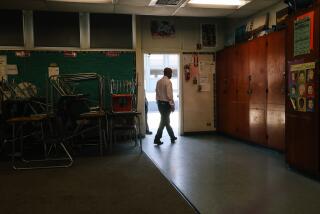School Officials Expect to Tread Water With New Budget
SACRAMENTO — For the fourth year in a row, Gov. George Deukmejian has put more new money into education than any other area of his budget.
But school and college officials said Friday that, rather than buying dramatic improvements in education, this year’s increases will mostly keep things on an even keel.
“We’re swimming hard just to stay even,” state Supt. of Public Instruction Bill Honig said, because much of the new money will pay for 100,000 extra children who are expected to enroll in the state’s public schools in the next school year.
The schools will get 5.8% more for each student enrolled next year, and the governor proposes to fund a variety of education reforms that were enacted in 1983. The schools are also set to get their first checks from the lottery next month, extra revenue that could total $331 million in the fiscal year beginning July 1. But Honig noted that this huge sum amounts to only $75 a child.
“It’s a good budget for us, but not a great budget,” said William Baker, University of California vice president. “But it follows on two great budgets,” he added.
The UC professors are scheduled for a 5% raise next year, while those at the 19 California State University campuses are set for a 6.8% pay increase. Both figures will keep the faculties even with or slightly ahead of professors at comparable universities across the nation.
For university students, Deukmejian’s budget means another year with no fee increases. Student fees at the UC campuses will stay at about $1,300 a year, while Cal State students will still pay about $640 in annual fees.
Community college officials were cheered by the budget because, for the first time in recent years, the two-year colleges did as well as the other segments of the educational infrastructure. Joshua Smith, the community college chancellor, said the 7% increase is “encouraging,” although he branded it a “stability budget, not a reform budget.”
Deukmejian has said that before suggesting changes or big budget hikes for the community colleges, he will wait for the results of the Master Plan Review Commission scheduled to deliver its final report on the colleges in late February.
Smith, who has headed the community college system since September, said he has found the governor interested in the welfare of the troubled colleges.
“I don’t find him to be anti-community college at all,” Smith said.
Besides a general 5.8% increase for the community colleges, the governor also proposed spending $35 million to buy new instructional equipment, such as computers, and an extra $22 million to aid districts, such as Los Angeles, which are rapidly losing students.
But by far the largest part of the budget--33% of all state spending and $12.1 billion in general fund money--will pay to operate the public schools. That figure will be augmented by $3.6 billion from federal, state and local special funds.
Over the four years of Deukmejian’s Administration, state spending for schools will have gone up $5.5 billion. The per-pupil amount will have risen from $2,360 to $3,340 in 1987, an increase that exceeds the inflation rate by 23%, according to the Finance Department.
But most of this money has paid for increases in teacher salaries.
And while California’s per-pupil spending has increased to $3,296 this year, it still trails the national average of $3,413.
Several education leaders faulted Deukmejian Friday for ignoring crucial problems in the schools, notably the large classes and overcrowding.
“It sounds like a status quo budget” for the schools, Senate Education Committee Chairman Gary K. Hart (D-Santa Barbara) said. “He’s funded SB 813 (the education reform law sponsored by Hart), but there are no new initiatives. He’s doing nothing about class sizes and overcrowding.”
California has the nation’s largest school classes, and Hart has twice sponsored bills that would have reduced some class sizes, only to have Deukmejian veto them as too costly.
Marilyan Russell Bittle, president of the California Teachers Assn., applauded the governor for making education his top budget priority, but also criticized his failure to fund smaller classes.
“Everyone talks about that and every report says (large classes are) our biggest problem, but he’s not done anything to address it,” Bittle said.
Although Deukmejian proposed no new spending to build schools in overcrowded areas, he said he would support a state bond issue to pay for them. Based on a recent survey, his office said the state will need to spend $4 billion to construct or refurbish schools in the next five years.
Democratic leaders of the Legislature also pointed to the problems of overcrowded schools in messages earlier this week and said they may seek to pass spending bills to construct schools even without the governor’s backing.
More to Read
Sign up for Essential California
The most important California stories and recommendations in your inbox every morning.
You may occasionally receive promotional content from the Los Angeles Times.









